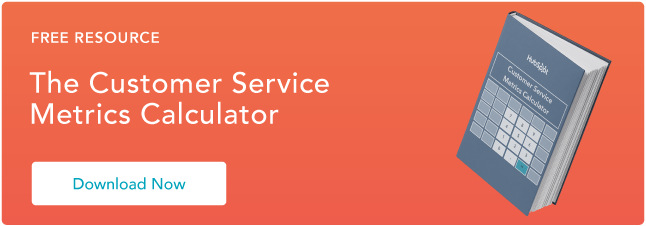CAC, or customer acquisition cost, is a crucial business metric used by companies around the world. It determines the resources that are needed for a company to attract new customers and continue its growth. If you want your business to expand its customer base and still make a profit, then it's important to understand what CAC stands for, its significance, and how your team can calculate it.
But, before we get started, here's a table of contents to help you find exactly what you're looking for.
Table of Contents
- What does CAC stand for?
- Customer Acquisition Cost (CAC)
- CAC Formula
- How to Calculate Customer Acquisition Cost
- LTV to CAC Comparison
- LTV to CAC Ratio
- Customer Costs by Industry
- How to Improve Customer Acquisition Cost
What does CAC stand for?
CAC stands forcustomer acquisition cost.A company's CAC is the total sales and marketing cost required to earn a new customer over a specific time period.
![→ Download Now: Customer Service Metrics Calculator [Free Tool]](https://no-cache.hubspot.com/cta/default/53/e24dc302-9dc2-466f-a5ca-ab4e08633c0f.png) Successful companies are aiming to constantly reduce thecost of customer acquisition— not just to recoup revenue, but because it's a sign of the health of your sales, marketing, and customer service programs.
Successful companies are aiming to constantly reduce thecost of customer acquisition— not just to recoup revenue, but because it's a sign of the health of your sales, marketing, and customer service programs.
Customer Acquisition Cost (CAC)
Customer Acquisition Cost (CAC) measures the cost of converting a potential lead into a customer. Businesses will use this metric to determine their profitability because it compares the amount of money they spend on attracting customers against the number of customers they actually gained.
Reducing this value means that the business is spending money more efficiently and should see higher returns in their total profit.
Think about it: If your inbound marketing program is operating successfully, you don't have to dedicate as many resources to ad spend to generate poor-fit leads when your blog content is bringing in high-quality organic leads 24 hours a day. If your sales team is constantly prospecting and nurturing a healthy pipeline, you don't need to rush to hire additional reps to hit your quota each quarter.
And if your customer success team is able to retain and cultivate relationships with happy customers, they will help generate new customers by writing testimonials and reviews, serving as case studies, and telling their friends and family about you. If the leads from these sources become customers, you will have earned them free of charge, which will lower your cost of customer acquisition even further.
If your company is looking to lower its CAC, you first need to know how to calculate your current customer acquisition cost. Below is the formula that you can use to calculate CAC for your business.
CAC Formula
We can calculate customer acquisition cost by using this formula: Customer Acquisition Cost = Cost of Sales and Marketingdividedby the Number of New Customers Acquired.
We can see how this formula plays out in the graphic below.

If you're not sure of what your "cost of sales and marketing" may be, consider the following expenses for this metric.
Ad Spend
Ad spend is the money you're spending on advertisement. For some businesses, advertising is a great way to attract new customers, but it's important to invest in campaigns that'll resonate with your target audience. If you're not sure whether you're getting a good return on a marketing campaign, you can calculate its value by dividing the revenue that's produced by advertisement by the amount of money you spent on that campaign.
Employee Salaries
Great employees are always worth the investment. So, pay close attention to how you approach this cost if you feel it's too high. There may be alternative options for reducing money spent on salaries, other than issuing pay cuts or layoffs. For example,chatbotsandmarketing automationcan supplement your team's workflow and improve your company's overall productivity.
Creative Costs
Creative costs are what you spend on creating content. This could be money spent on acquiring talent to promote your company or it could be what you spent on lunch for your team meeting. All of these costs factor into content production.
Technical Costs
技术成本指的是你的技术marketing and sales team use. For example, if you purchased areporting toolthat tracks the progress of your open deals, that would be a technical cost.
Publishing Costs
Publishing costs are what's spent to release your marketing campaign to the public. This could be money spent on TV air time, paid social media ads, or a spot in a newspaper or magazine.
Production Costs
Production costs are the costs associated with physically creating content. If you're making a video, you need to buy a camera, create a set, edit the video, etc. These costs add up, especially if you're paying a third-party to produce your content.
Inventory Upkeep
Even if you're aSaaSbusiness, you'll have to spend money on maintaining and upkeeping your products. If you're providing software, this is the money you spend on updates and patches to the user experience.
Now that we're familiar with the CAC formula, let's put it to action with an example.
How to Calculate Customer Acquisition Cost
To calculate customer acquisition cost, the first step is to determine the time period that you're evaluating for (month, quarter, year). This will help you narrow down the scope of your data. Then, add together your total marketing and sales expenses and divide that total by the number of new customers acquired during the time period. The result value should be your company's estimated cost of acquiring a new customer.
For example, let's say your company spends $500K on sales and $300K on marketing. Additionally, your company generated 800 new customers during the last fiscal quarter. If we were to calculate the CAC for your business, the cost to acquire a customer for that quarter would be $1K ((500K + 300K)/800= 1K).
Once you have calculated CAC for your company, you can compare this value against other key business metrics. By doing so, you'll uncover important insights about your marketing, sales and customer service campaigns.
Featured Resource:Free Customer Acquisition Cost Calculator
LTV to CAC Comparison
One metric to analyze in relation to customer acquisition cost is acustomer's lifetime value(LTV). LTV is the predicted revenue that one customer will generate over the course of their relationship with a company.
To calculate LTV, you'll need a few variables to plug into the formula:
Average purchase value: Calculate this number by dividing your company's total revenue in a time period (usually one year) by the number of purchases over the course of that same time period.
Average purchase frequency: Calculate this number by dividing the number of purchases over the course of the time period by the number of unique customers who made purchases during that time period.
Customer value:Calculate this number by multiplying the average purchase value by the average purchase frequency.
Average customer lifespan:Calculate this number by averaging out the number of years a customer continues purchasing from your company.
Then, calculate LTV by multiplying customer value by the average customer lifespan. This will give you an estimate of how much revenue you can reasonably expect an average customer to generate for your company over the course of their relationship with you.
Thus, your company's LTV to CAC ratio, or LTV:CAC, is a quick indicator of a customer's value relative to how much it costs to earn them.
LTV to CAC Ratio
Businesses use LTV to CAC ratio (LTV:CAC) to guide spending habits for marketing, sales, and customer service. LTV:CAC shows a brief snapshot of how much customers are worth compared to how much the business is spending to attain them.
Companies should aim to find the right balance for this ratio to ensure they're getting the most out of their financial investments.Ideally, it should take roughly one year to recoup the cost of customer acquisition, and your LTV:CAC should be 3:1 — in other words, the value of your customers should be three times the cost of acquiring them.
If it's closer to 1:1 that means you're spending just as much money on attaining customers as they're spending on your products. If it's higher than 3:1, like 5:1 for example, that means you're not spending enough on sales and marketing and could be missing out on opportunities to attract new leads.
At this point, you may be wondering what a good CAC looks like? Well, that may vary depending on your industry. To give your team a better idea of what to strive for, the next section breaks down average customer acquisition costs for different industries.
Customer Costs by Industry
Customer acquisition cost varies across industries due to a number of different factors — including, but not limited, to:
- Length of sales cycle
- Purchase value
- Purchase frequency
- Customer lifespan
- Company maturity
So to put CAC into context, here's a rundown of average customer acquisition cost by industry (as estimated by a fewdifferentpublications:
- Travel: $7
- Retail: $10
- Consumer Goods: $22
- Manufacturing: $83
- Transportation: $98
- Marketing Agency: $141
- Financial: $175
- Technology (Hardware): $182
- Real Estate: $213
- Banking/Insurance: $303
- Telecom: $315
- Technology (Software): $395
How to Improve Customer Acquisition Cost
There are a few different ways to improve your cost of customer acquisition to bring that LTV:CAC ratio closer to 3:1. Here are a few strategies to work towards:
- Invest in conversion rate optimization (CRO):Make sure it's simple and straightforward for visitors to convert into leads, or for leads to convert into customers and make purchases on your site. Optimize your site for mobile form submissions and shopping, test website copy to make sure it's as clear as possible, and try to create a touchless sales process so your visitors can buy from you 24/7.
- Add value:Increase customer value by giving customers what 's valuable to them.Collect customer feedback, and whether it's a product fix, a new feature, or a complementary product offering, do your best to give customers what they're asking for to make them stick around longer.
- Implement a customer referral program:If your customer refers you to a warm lead from their network who is already interested in learning about your product or service, their particular CAC will be $0 if they convert. These "free" customers will lower your CAC over time, so build acustomer referral programyour customers want to participate in.
- Streamline your sales cycle: Decrease the length of a typical sales cycle to increase the number of sales you can influence over the course of a year. Use aCRMandprospectingtools to connect with more qualified leads more effectively.
Want more ideas? Read about how to use content marketing in yourcustomer acquisition strategynext.
Originally published Jan 16, 2020 10:40:00 AM, updated November 19 2021
Topics:
Customer AcquisitionDon't forget to share this post!
Related Articles


![How to Ask for a Referral From a Client [+ Best Email Templates]](http://www.eigoj.com/hubfs/referral-FI.jpg)
Expand Offer
客户服务指标计算器
Get it now


